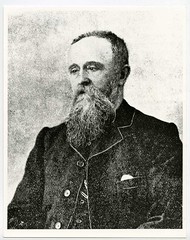James Nash Howard Strong, 1840-1924
Howard Strong, who became librarian in 1908, was the first librarian of Canterbury Public Library to be appointed solely as its librarian. When he replaced Alexander Cracroft-Wilson, he was 68 years old but he had been responsible for the day to day running of the public library since being appointed sub-librarian in 1879. Strong lived in the librarian’s house in Cambridge Terrace next to the library. While Francis Stedman and later Alexander Cracroft-Wilson were busy with their university duties he ran the library. When the Mechanics’ Institute handed control of the public library to Canterbury College in 1873, the College’s registrar assumed responsibility for the work of the library. Both Francis Stedman and Alexander Cracroft Wilson were first and foremost, university registrars; library work was very much a secondary role.
Sailor, teacher, soldier
Strong had had an interesting and varied life before being appointed to the library staff. He was born in Exeter, the son of William Strong, an attorney, and his wife, Elizabeth G. Strong, and was the youngest of three children. Howard was educated at a private school in Newton Abbot and then at Vilvorde near Brussels. After three years at sea, he emigrated to New Zealand, arriving on the Victory in 1859. He appears to have spent time in Canterbury – in 1860, he applied for a post as assistant schoolmaster in Okains Bay under the Rev. Henry Torlesse – but later moved to Wanganui, where he joined the Yeomanry Cavalry, a special corps enrolled under the auspices of the Colonial Defence Force Act (1862).
Colonial Wars
He was involved in several skirmishes during the 1860s wars in the Taranaki-Wanganui region, including the battle at Nukumaru in January 1865, when many colonial forces were killed, and the capture of Werawoa Pa in July 1865, under the leadership of Governor George Grey. In 1868, he moved to the Poverty Bay area, taking up land near Patutahi. The rise of Te Kooti saw him rejoin the colonial forces as a local volunteer, this time serving under Colonel George Whitmore, an immensely unpopular man who was nevertheless a very capable military commander. Throughout 1868 and 1869, Strong was involved in various battles against Te Kooti and Titikowaru, including the invasion of the Ureweras in May 1869. Strong’s military endeavours were rewarded with the presentation of a New Zealand War Medal.
Strong remained in Poverty Bay for 11 years. In 1875, he married Florence Bach, the daughter of Mr. W. Bach of Birmingham. Their family of 5 sons and 2 daughters were born between 1876 and 1893. A third daughter died at the age of 10. During his time in Poverty Bay, Strong became a Freemason, being initiated in Gisborne.
Becoming a Librarian
Howard Strong and his family returned to Christchurch in 1879, when he was appointed as sub-librarian at the public library, accommodation being provided for him on the library premises. After his arrival in Christchurch, he joined both the Canterbury Veterans’ Association and the Canterbury Pilgrims’ Association.
Because of his advanced age, Strong served as chief librarian for only a short time. Perhaps the most significant innovation of his brief tenure was the opening of a children’s library in 1909. By the time of his retirement early in 1913, over 400 children were enrolled as readers. After he retired, Strong and his wife moved to Redcliffs, although towards the end of his life, ill-health necessitated living with one of their daughters in Cranmer Square. Strong died on 21 September 1924, and is buried in Bromley Cemetery, along with his wife, two sons and a daughter-in-law.
Sources
- Obituary, The Press, 23 Sept 1924, p. 11
- Cyclopaedia of NZ, v. 3, p. 167
- Ancestry.com, Church Register Index, CCC cemeteries database
- M. Moorhead, First and strong, pp. 48-9
- Biography of George Stoddart Whitmore, DNZB
- MacDonald Biographies (S850)


 Discover your family’s history at our libraries
Discover your family’s history at our libraries
